Have a new plant baby? Looking for the perfect pot? Overwhelmed by the hundreds of options of pots? I’ve been there. That’s why I keep going back to a classic – terracotta pots!
Are you looking to use indoor terracotta pots for your next plant? There a few things you need to know to use them the best way possible.
One thing to know is terracotta pots are made from baked clay. “Terracotta” translates to “cooked earth” in Italian. Pretty cool, right?
The red/orange coloring comes from the the iron content in the clay that reacts with oxygen. Pretty soon you’re going to be pro at all things terracotta and wow your friends with all these facts. 😉
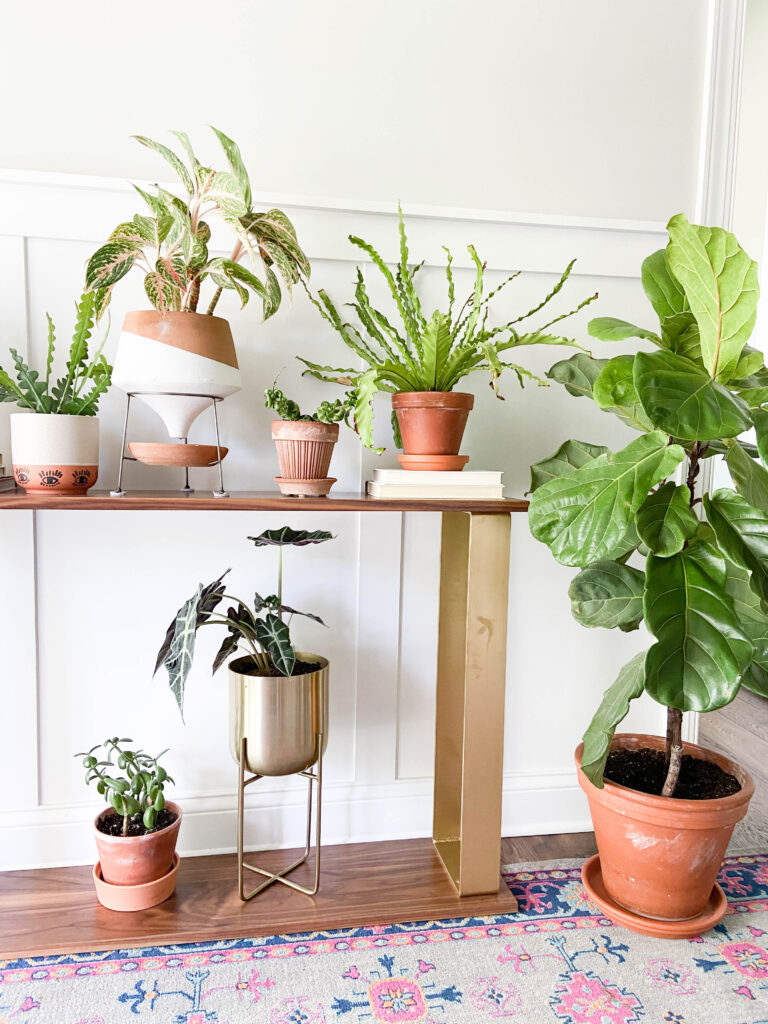

Paisley + Sparrow is a participant in the Amazon Services LLC Associates Program. This post may include affiliate links which means I may earn a small commission if you shop using the links below at no additional cost to you. Thanks so much for supporting me and this blog!
Terracotta pots are the best. They’re super inexpensive. They’re timeless. They can also be easily painted and personalized (like on this DIY personalized pot post).
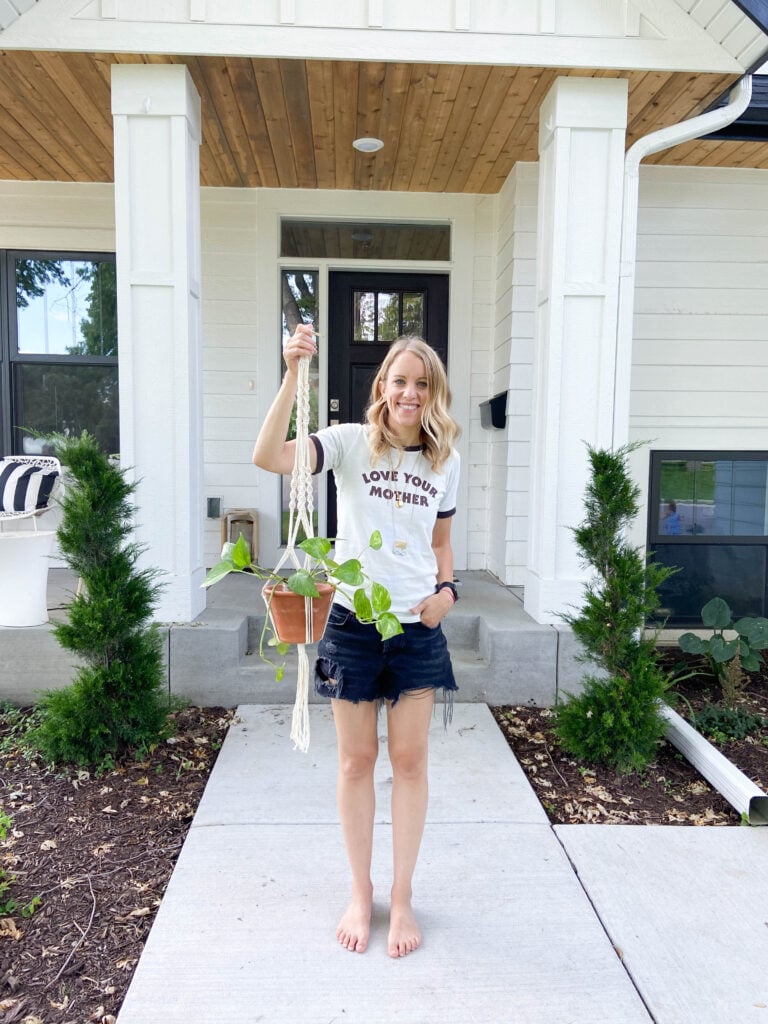
And I adore how they’re super on trend right now! I’ve used them as a tablescape for a home I helped style and they go so well with macrame plant hangers (find a simple macrame plant hanger DIY here). They go so well with natural wood, white rooms and macrame everything!
Terracotta Pots Pros
Terracotta pots have a lot of pros. They’re great for plants because they’re porous and allow air and water to flow through them. This helps prevent root rot or soil disease which could kill your plants. They can be used both indoors and outdoor – great for a place like Minnesota, where I live!
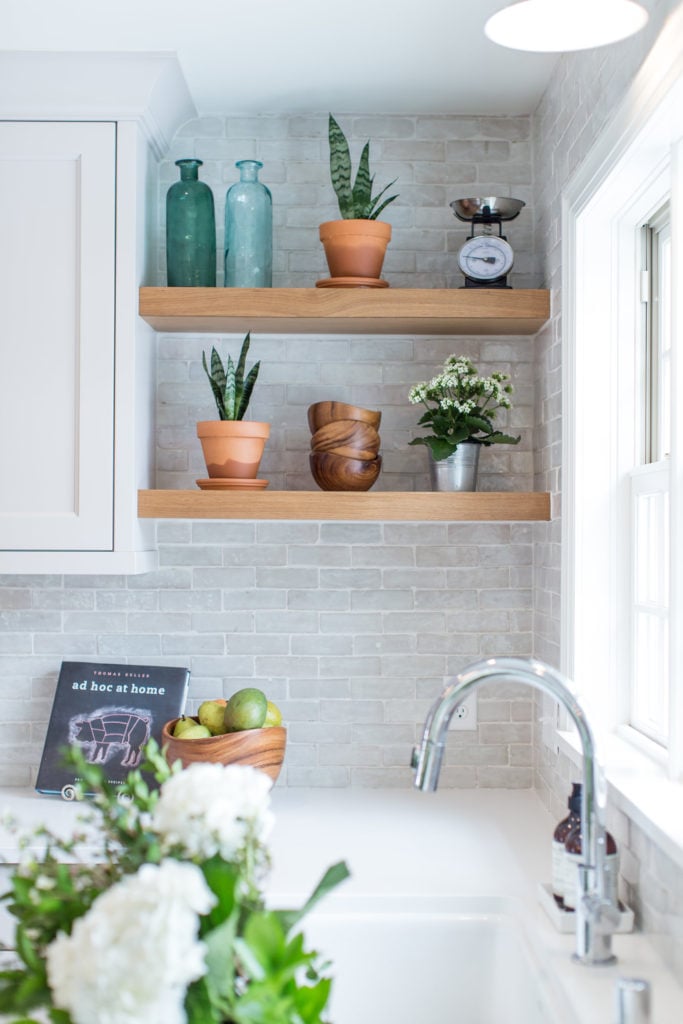
They have drainage holes on the bottom and typically come with matching saucers which also helps water to flow through and prevent soggy soil. The drainage hole helps your plant not retain too much water, so they’re a good idea for plants prone to root rot!
They’re also inexpensive. You can keep costs low when adding plants to your home by getting terracotta pots! You can get an 8.5-inch pot from Home Depot for just $4.98 or six 5.5-inch pots from Amazon for around $25.
Plus, they’re timeless. Terracotta garden pots go with everything and if you decide you’re over the color, they can be painted!
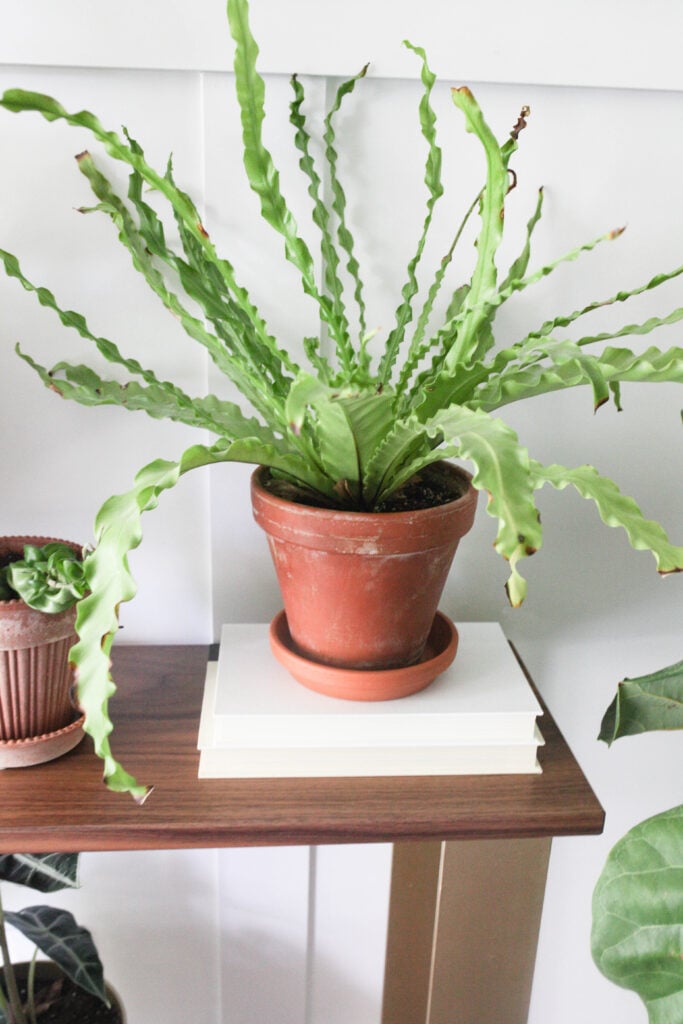
They can be used indoors or outdoors. This is especially helpful for plants that you leave outside during warm months and take inside during colder months.
Terracotta Pot Cons
There are a few issues that come with using terracotta pots, but not many!
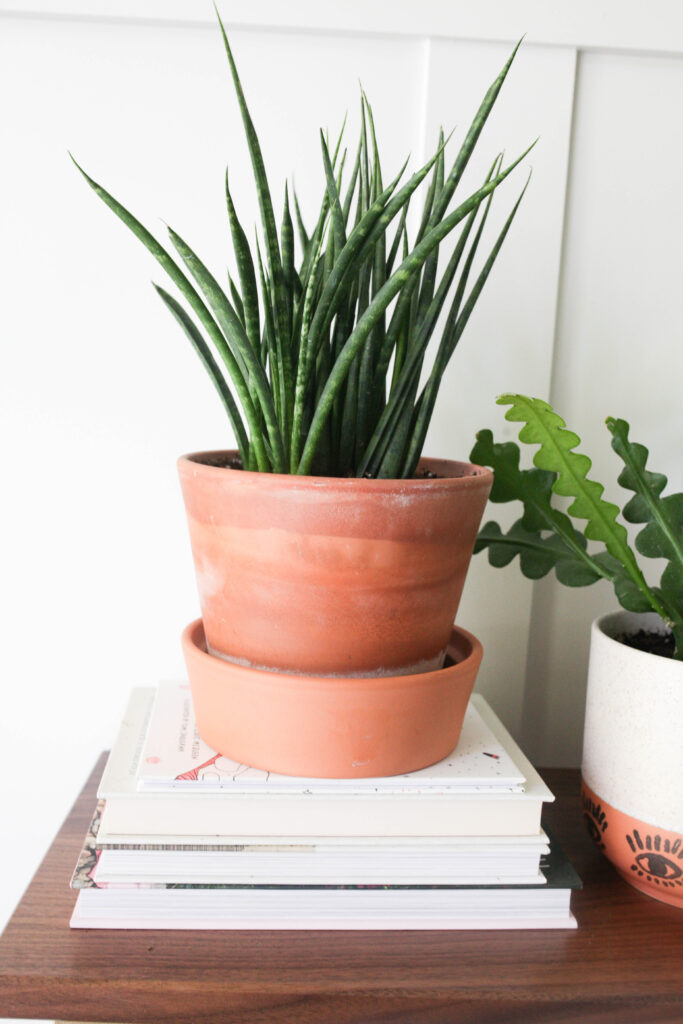
First up, they can crack from the cold (or being mishandled). You need to be gentle when using terra cotta pots, especially when you’re moving them to different locations or handling them in the cold.
They can require more frequent watering than in other non-porous pots. Like mentioned above, terracotta pots are made from baked clay. This makes it super easy for water to pass through the pot which helps with things like preventing root rot, but it will often time mean you need to water your plant more.
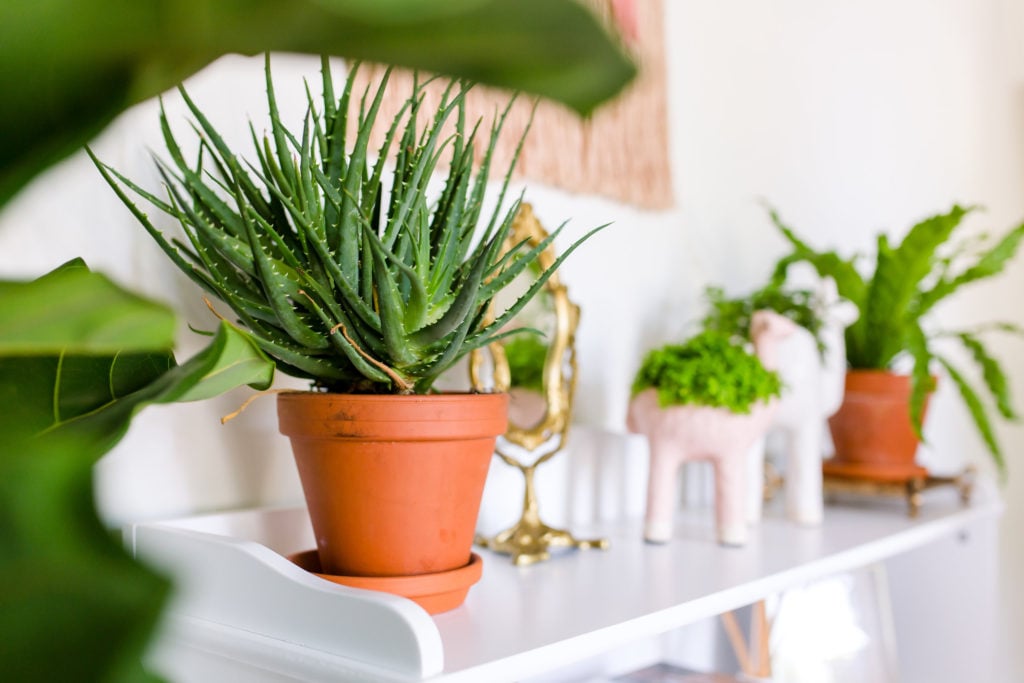
I’ve been using terracotta pots for years and have learned a few tricks on how to best use them. Do these three terracotta tricks for your next plant baby!
3 Tips When Using Terracotta Pots
Tip 1: Soak your pot!
The number one rule of thumb when using terracotta pots is to soak them prior to use them! These pots are made out of clay so doing this will prevent the pot from stealing of your plants precious water.
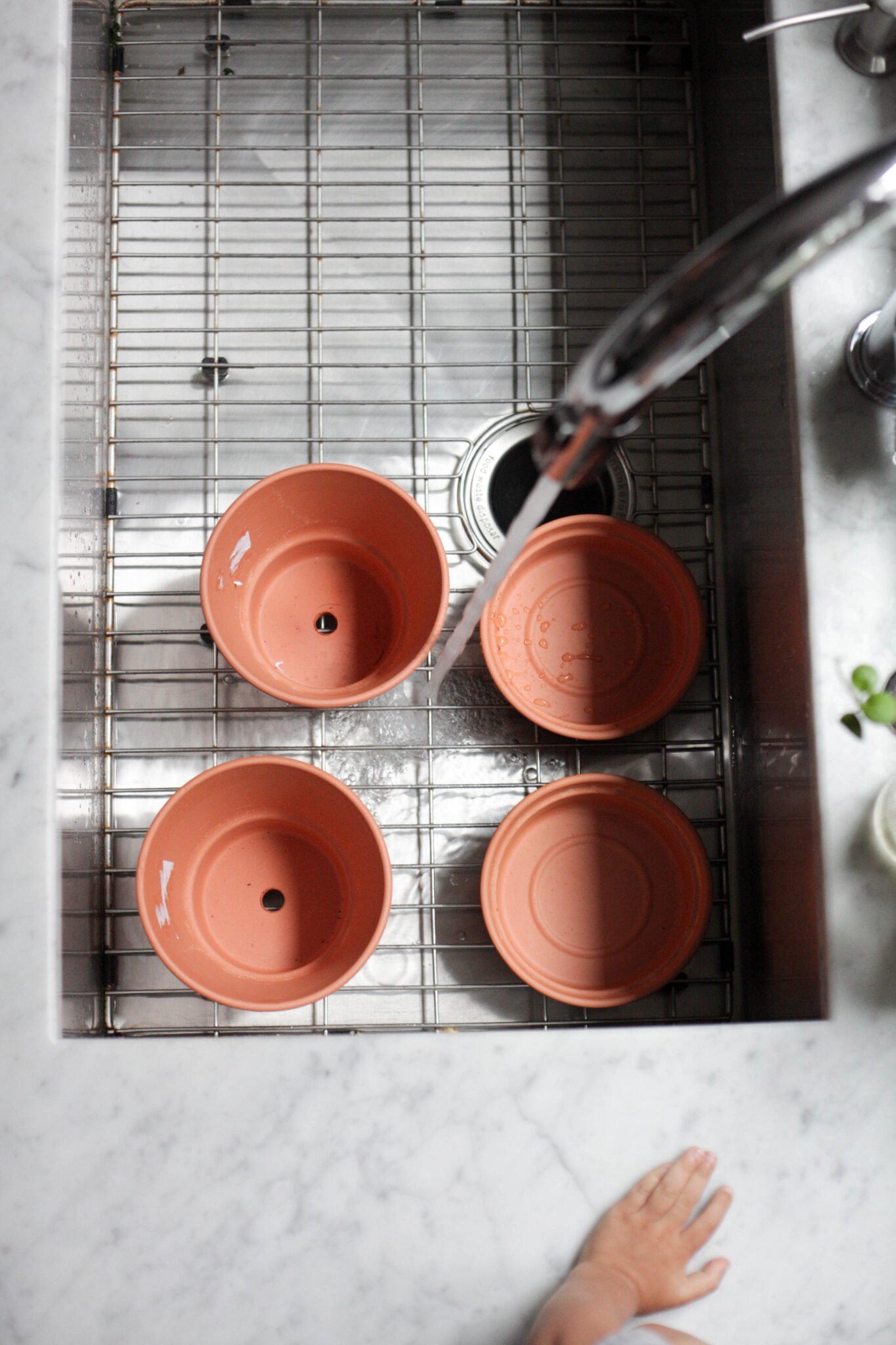
How long do you need to soak your terracotta pots?
Fill up a sink and soak them overnight or at least for 30 minutes prior to potting them.
Side note: It’s also great entertainment for toddlers. 😉 I love getting our kids involved in the planting process. I’ve done everything from soaking pots to propagating pothos plants to potting new plant babies with our kids. Now they can’t wait when I come home with a new plant to learn about!
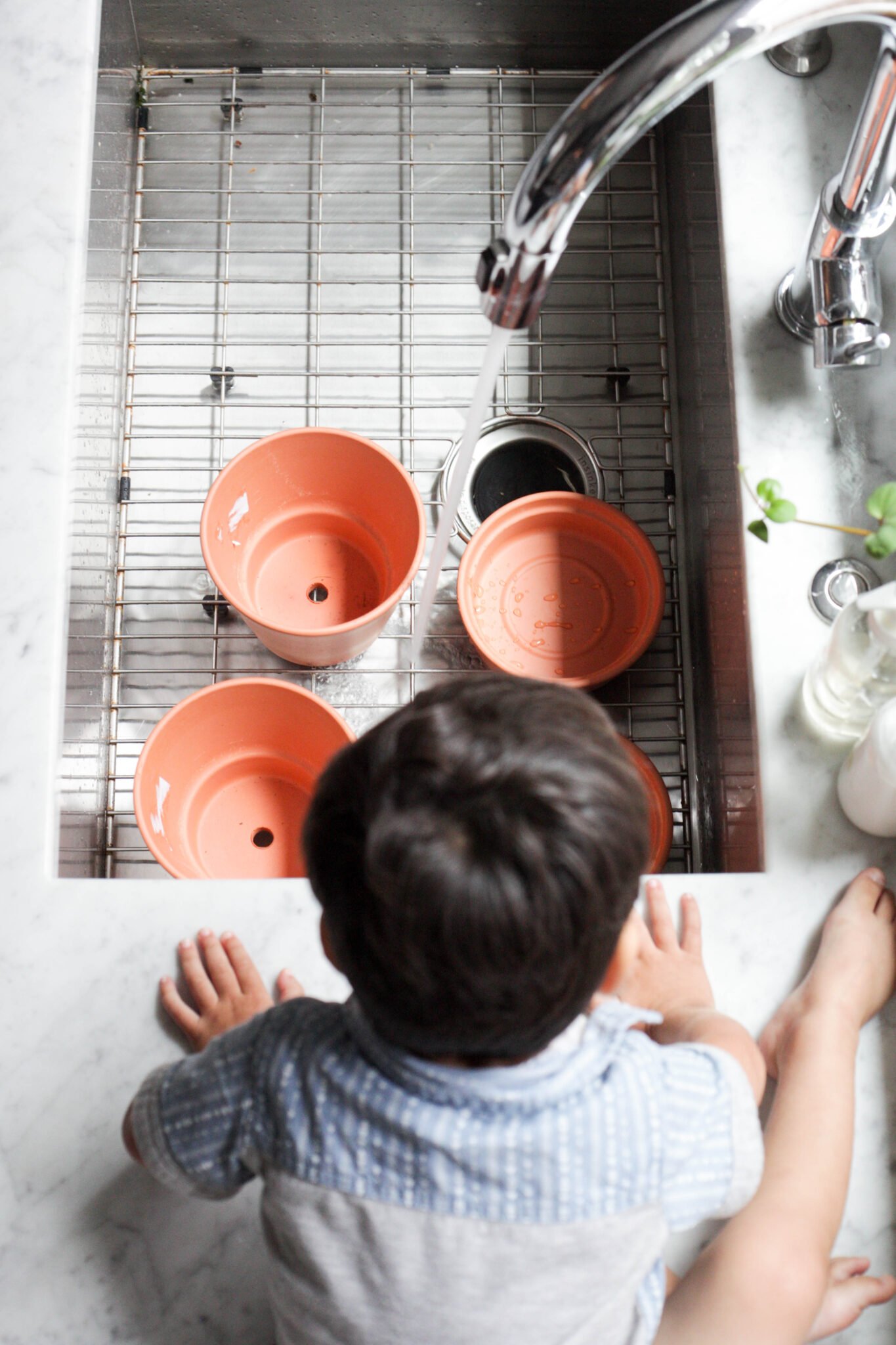
Tip 2: Use a coffee filter.
No, this tip isn’t just because I love my coffee. 😉 Terracotta pots typically have drainage holes in the bottom. By putting a coffee filter in the pot, you’ll keep the soil in the pot but allow the water to still drain.

Don’t worry if your pot is still wet from soaking it. (My toddler was very concerned about that when I put the coffee filter in – ha!)
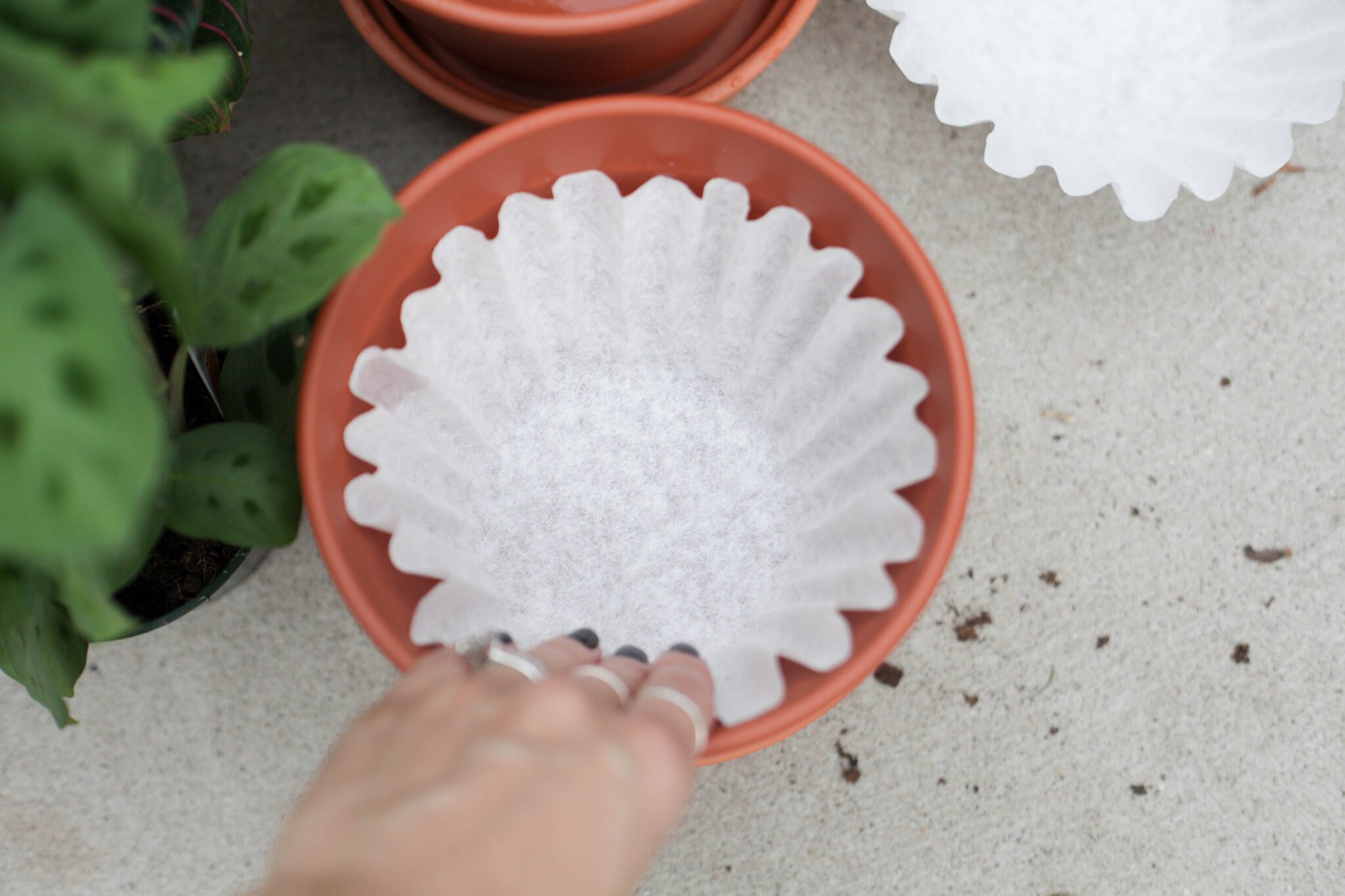
Simply press the coffee filter into the bottom and against the sides. When you add soil try to keep the soil from falling in between the filter and the pot but it’s ok if a little bit slips in.
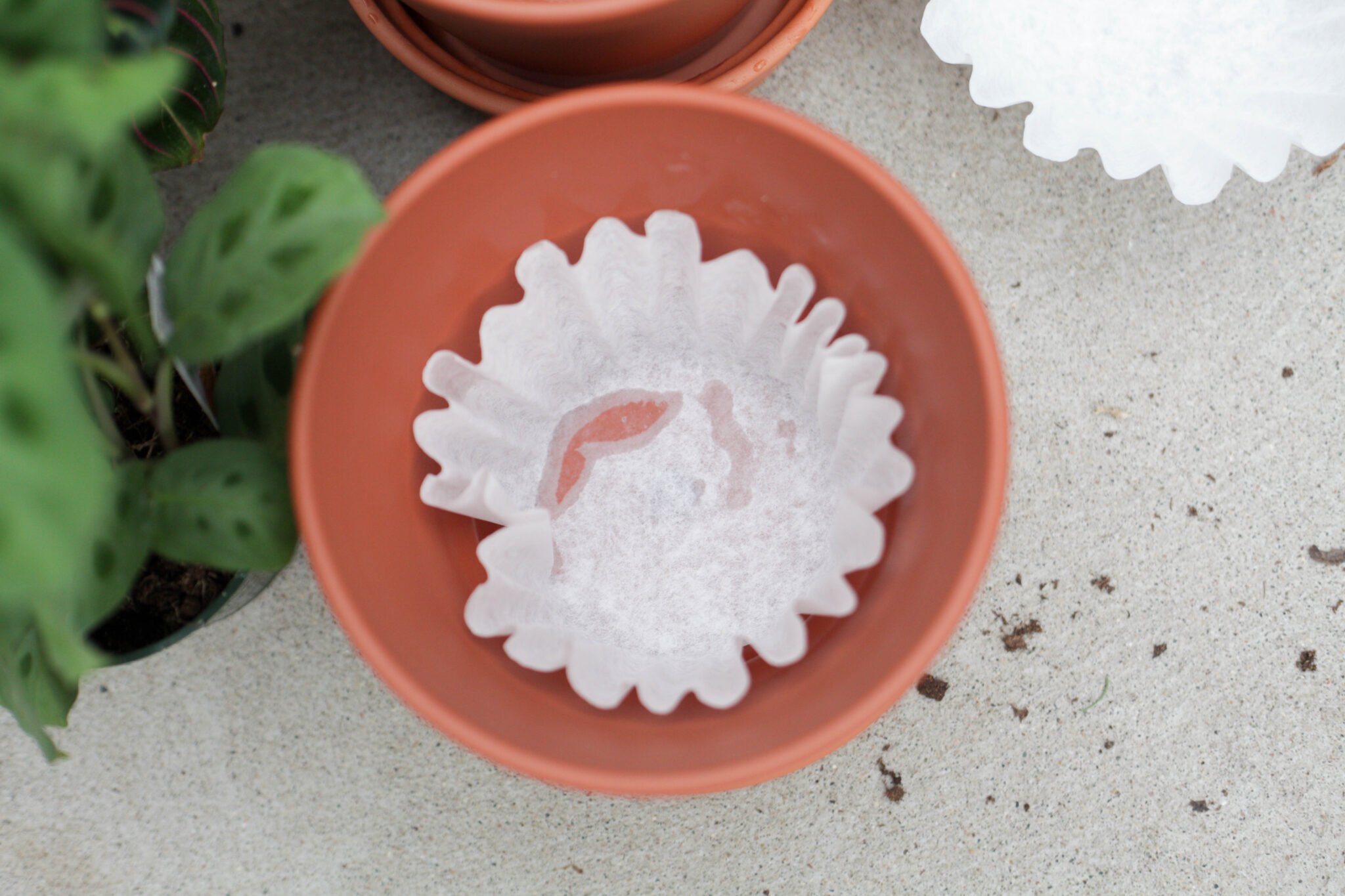
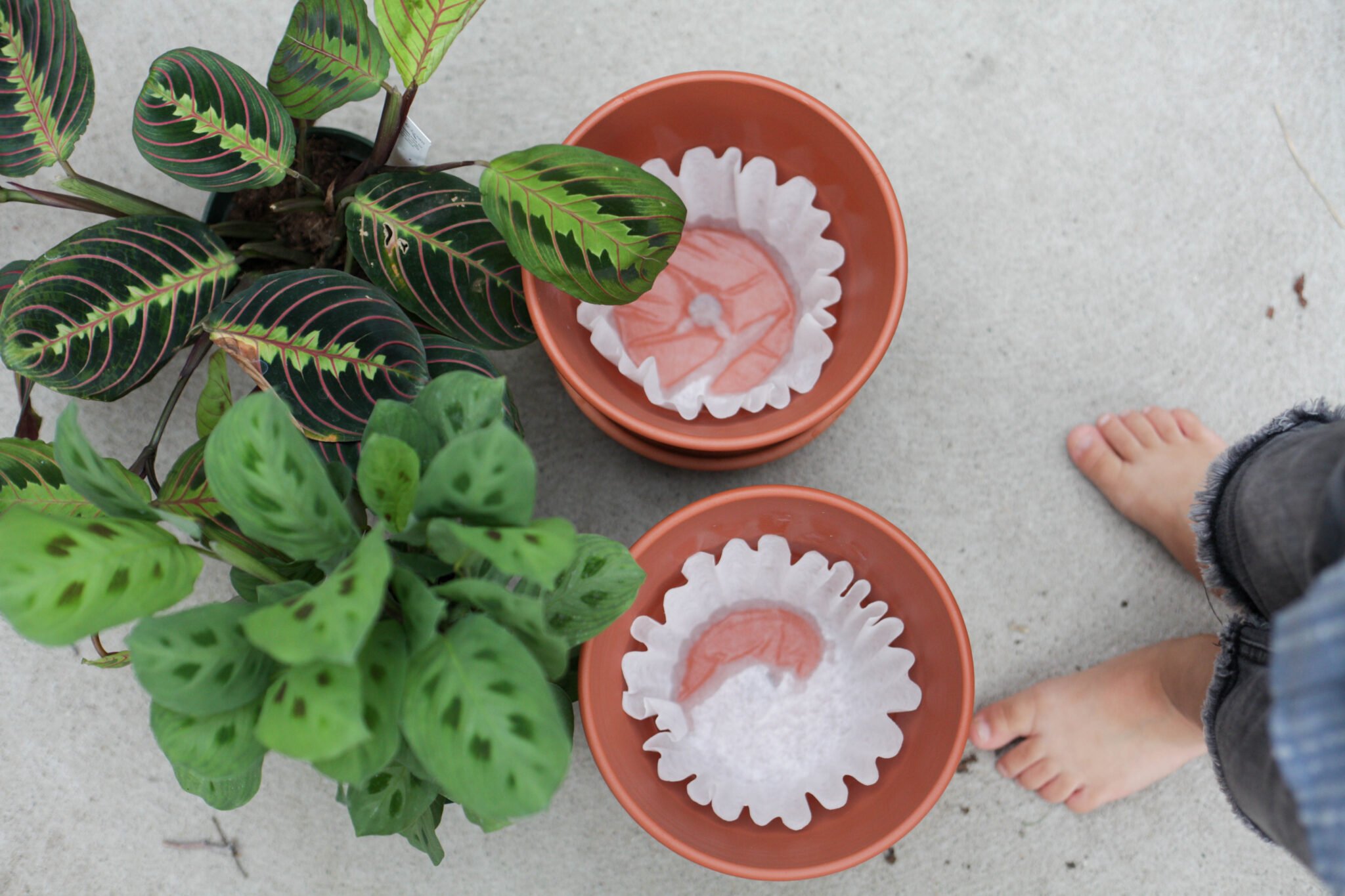
Tip 3: Use a plastic saucer for under your pot.
Because the saucer that you get with your pot is also made out of clay, there’s a good chance it will ruin your floor or wood table/dresser/etc. when you water it.
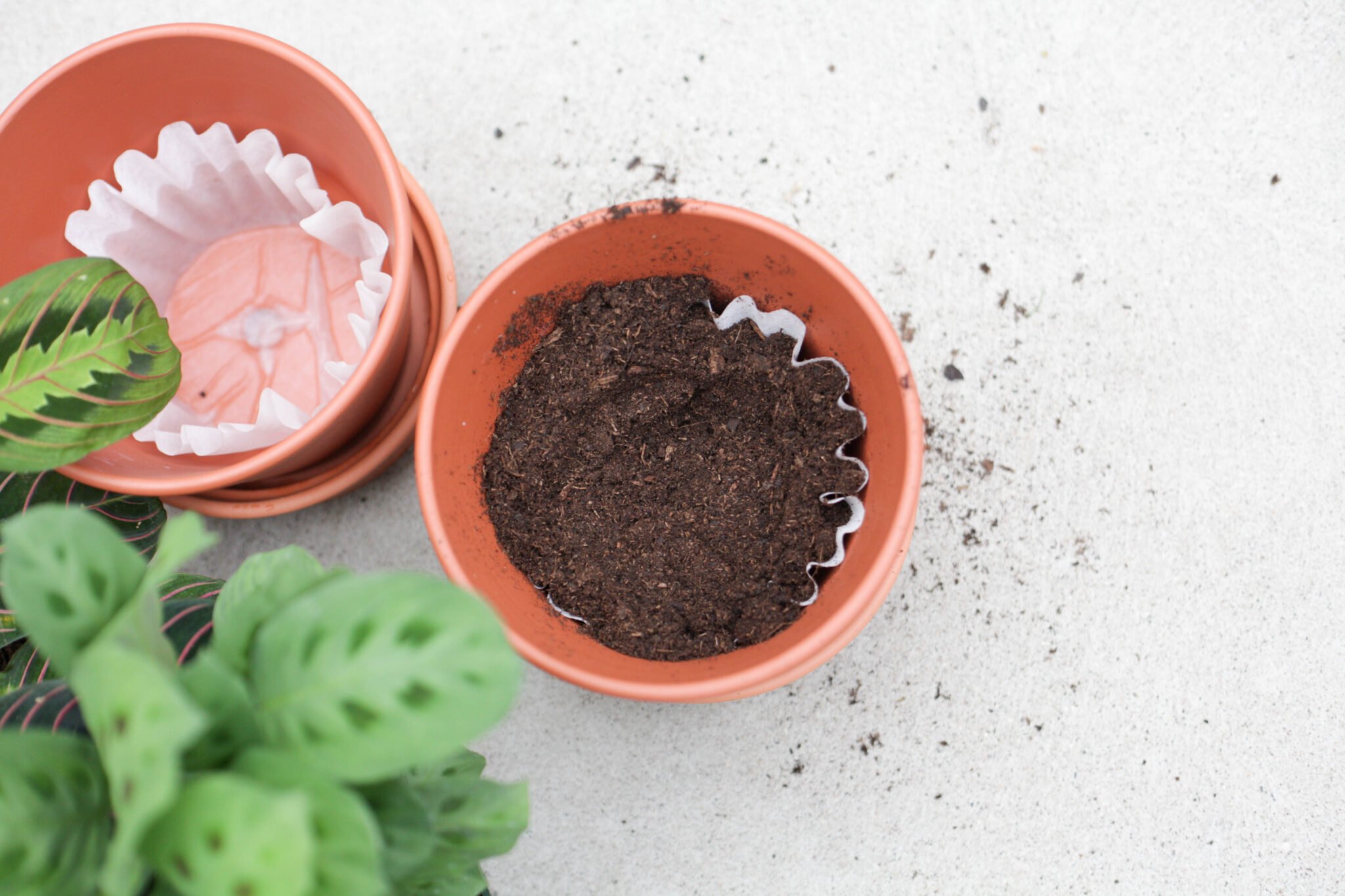
Save your home and put a plastic saucer like these from Amazon underneath your pot! It doesn’t necessarily need to be plastic but something that will go in between your pot and carpet or wood.
And that’s it! Super simple things that will make a huge difference the next time you use a terracotta pot.
How to Clean Terracotta Pots
You may notice that after you’ve been using your pot for a long time, it will develop a crusty buildup or powdery white residue. The pots will start to absorb the minerals in the soil and will tarnish the pots with these mineral deposits.
Terracotta pots are also prone to growing white mold or a powdery mildew since the clay material absorbs so much liquid.
But they’re actually super easy to clean with just a little bit of elbow grease!
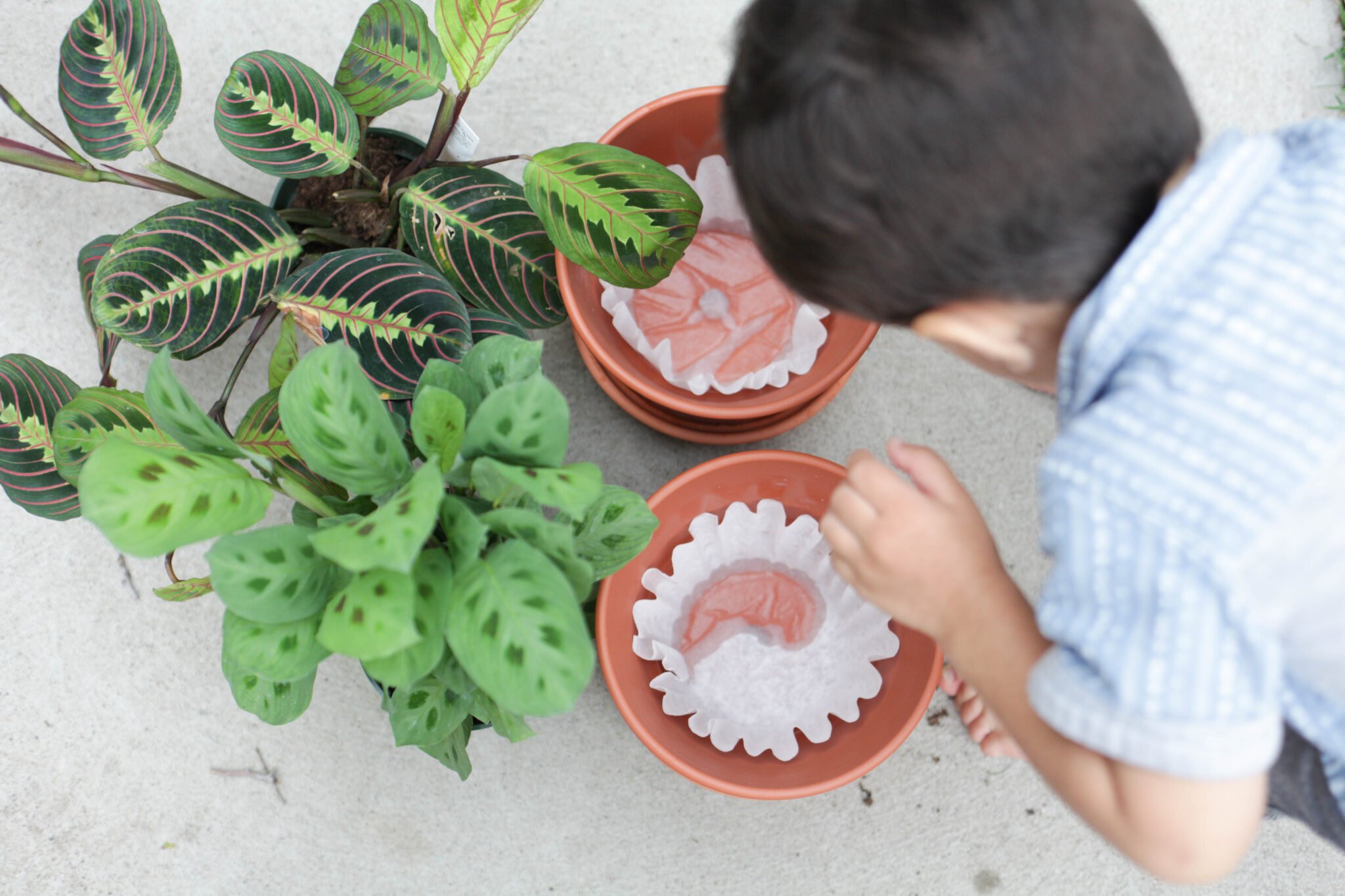
The first step: you’ll want to remove the plants from your dirty pots. The easiest way to get all the loose dirt out is to let it dry before scraping it out. Use a stiff wire brush or steel wool to scrape away all of the dry dirt and get the pot fully cleaned out.
Your next step is to soak it in a vinegar solution! This will help to not only clean but also disinfect it, which is vital if you’ll be using the pot for new plants. Use a ratio of 1 part vinegar to 4 parts warm water.
That should take away all of the white stuff and scum on the pot! If there’s still a bit left, you can use a baking soda and water solution to finish up the cleaning.
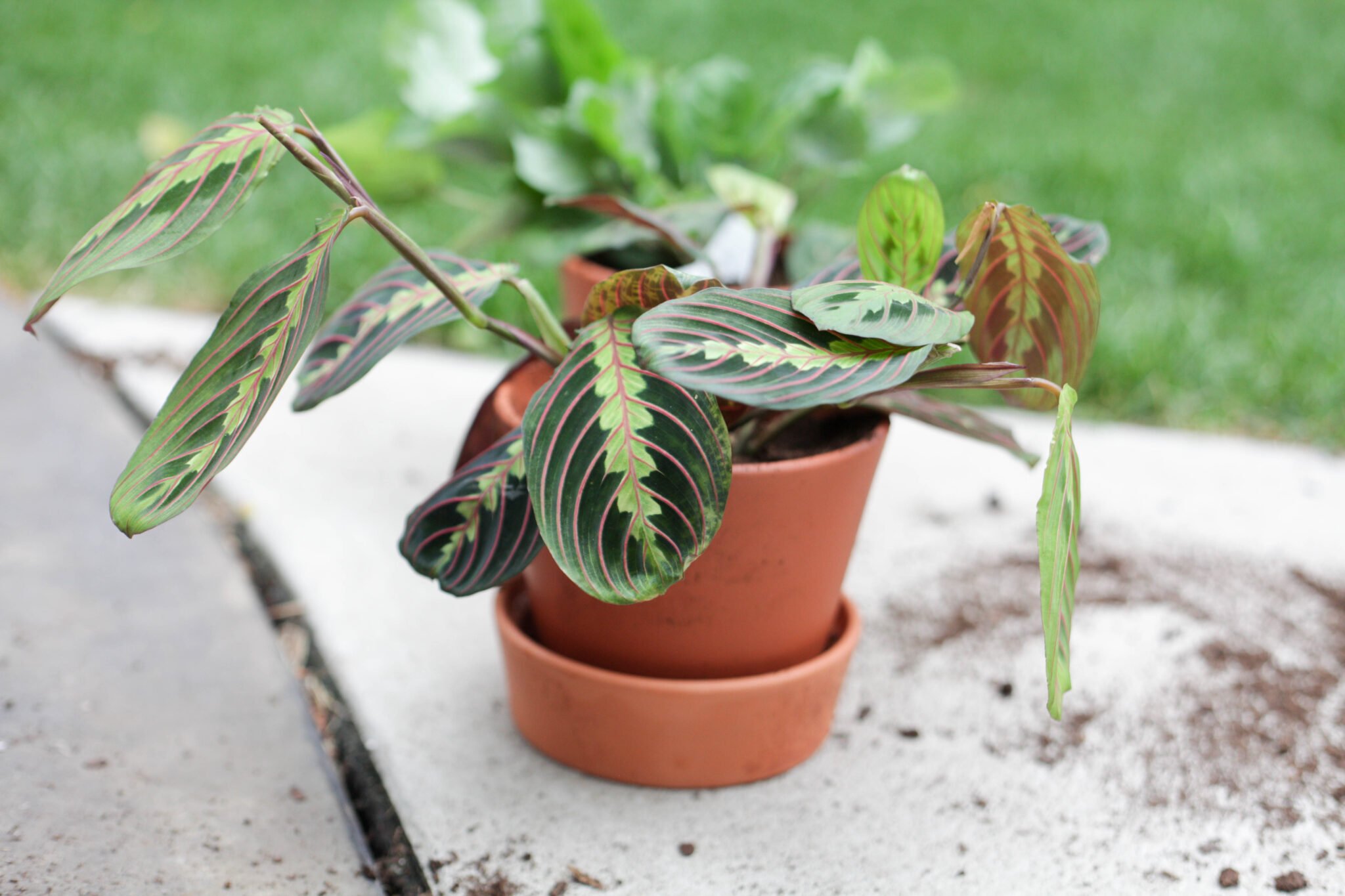
The final step is soaking it in bleach. Bleach can be damaging to terracotta pots so use it sparingly! Use a ratio of 1 part bleach to 10 parts water. Soaking it in this bleach solution will remove any fungus that could possibly be lingering on your clean pots.
You can help prevent the crusty white residue by changing the type of water and fertilizer you use. Rainwater or distilled water won’t have the minerals that tap water has, so it’s better for your terracotta pots. Similarly, organic fertilizers are better than chemical fertilizers.
Terracotta vs. Ceramic Pots
I love both terracotta and ceramic pots, but it definitely depends on which plant I’m using it for. Terracotta absorbs water from the soil, drying the soil out faster, but ceramic’s glaze means the soil stays much wetter. Terracotta pots also have drainage holes, and some ceramic pots do not.
That means terra-cotta pots are best for plants that need good drainage and like soil to dry out a fair amount before being watered. Succulents, cacti, Monstera, snake plants and ficus are just a few examples of plants that love terracotta planters.
Ceramic planters work well for water-loving plants, the kind that don’t mind if their roots sit in wet soil. Spider plants, pothos, and ferns are some of the plants that are perfect for ceramic pots.
There’s a lot more variety in color and look of ceramic pots than terracotta, so if you’re choosing one for a plant that could thrive in either, ceramic might fit your style better.
Best Terracotta Pots
The best terracotta pots are the ones that fit your budget, plants and style, so don’t feel like you have to spend a ton on a fancy planter. Here are three stylish planter options to get you started!
Provence Scalloped Edge Planter
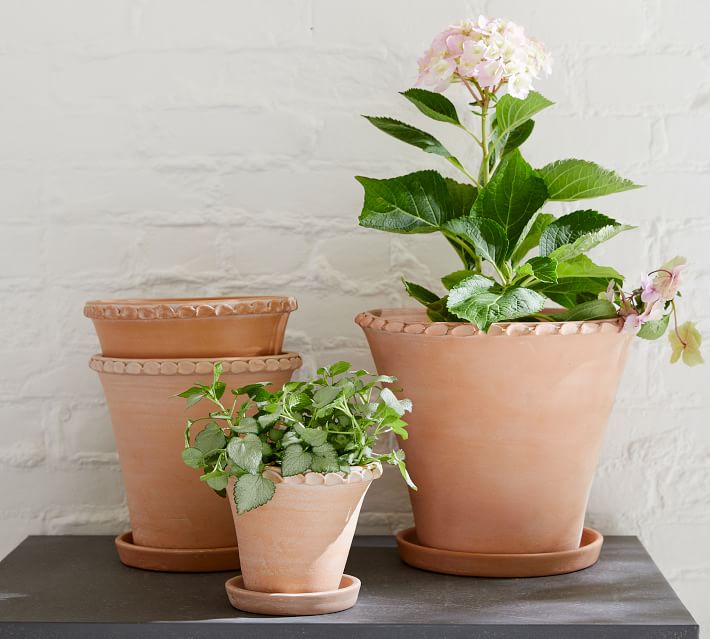
Bloom Room Terracotta Pot
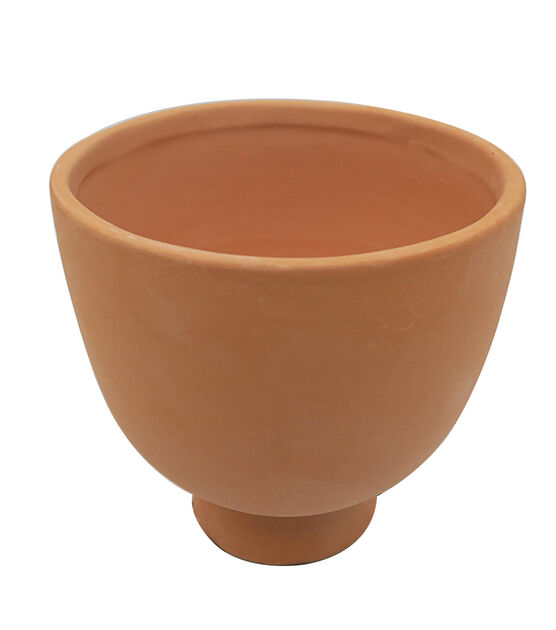
Whitewash Studio Planter
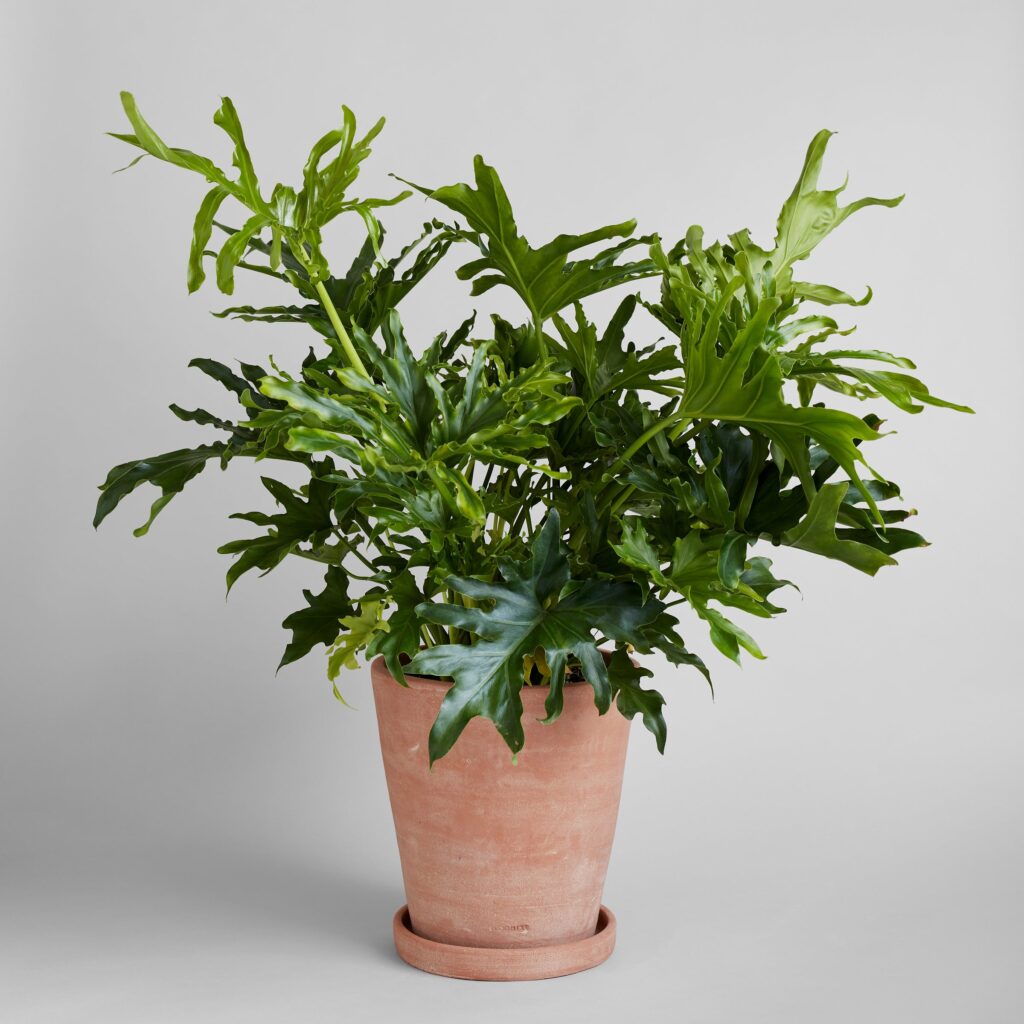
FAQ
Yes, the porosity of terracotta is great for plants that need good drainage and are prone to root rot. It’s also a good option for plants that need to be brought inside in cold weather because terracotta can be used inside and outside.
Terracotta is ideal for plants that do poorly in very moist soil, like succulents, cacti, snake plants, monstera, ficus, philodendron and more. If you’re considering a plant, look at the care instructions; if it prefers dry soil, terracotta is probably a good choice.
Terracotta is not waterproof. It’s porous and absorbent, so it will take in water that you pour into the soil. This is also why I recommend a plastic saucer instead of a terracotta saucer. The terracotta saucer will still allow water to slowly leak onto the surface below it.
This depends on the type of plant and the size of your pot! Smaller terracotta plants might dry out too fast for your small plant that is still getting established. You have to be more vigilant with watering (or at least checking the soil) when you’re getting used to terracotta or your plants are young.
What’s your favorite kind of plant to have in your house?
Be sure to check out what the 7 best plants for air purification are or some of my favorite plant stands so you can add more plants to your home! Or if you’re in the mood for a DIY, make a macrame plant hanger for your pot!
Thanks for reading!
Jen

Don’t know if anyone is still replying but hoping for some thoughts/advice. I had to use paint remover to clean some painted, thickly coated terracotta pots as nothing else was working to get the paint off. I’m concerned, because the pots are porous, about chemicals seeping into plants. Was wondering if I soak them over a few days in diluted vinegar water and change the water a few times, if that will help lessen potential chemical contamination of the plants. Any ideas would be greatly appreciated. Thanks 🥰
I don’t know for certain but if your plant is still inside your pot when you soaked it in chemicals it would likely get to your plant. You can water your plants in terracotta plants but placing them in a basin of water. The water soaks up through the drainage hole and through the porous material of the pot. If there was chemicals involved, they would then penetrate the roots. If I were you I would remove the plant and all of the soil, wash the roots really well and put it in fresh soil. I would also soak your pot to ensure all the chemicals have been removed. I hope that helps!
Should lovely terracotta pots be taken into garage during winter to protect from snow and freezing temps?
I just “discovered” terra cotta pots in the perfect shade and have fallen hard and fast. I found your article before I went out and invested in bringing a dozen home and now I feel even more confident in this design choice. Thanks for helping me feel prepared!
I love terracotta for my indoor plants over other more modern pots simply because of the drain hole. But I find that because the matching saucer could damage indoor surfaces, I’m steering away because the plastic pot saucers seem like such and eyesore to me. Anyone else feel this way and have found a better solution?
I superglued a large cork coaster to the bottom of my terracotta saucer. It prevents water damage and scratches on furniture IMO. ?
Can I use paper towel instead of coffee filter?
Thanku so much really enjoyed reading your tutorial and especially your info on the 7 best air purifying plants. Very helpful thanku so much cheers Kaz from Oz ?
Thank you for publishing this. Now I understand my pots better.
I started indoor gardening with an Aerogarden from Amazon. Now I have 2 of them. I decided to expand my indoor farm with veggies in regular soil. I use terracotta pots for those.
Thanks for the tip about the coffee filter! I’ve always used one uneven rock over the hole, to keep the soil in but still let water drain out. The coffee filter seems so much better!
You’re so welcome!
I just adopted a plant in a terracotta pot. This was a helpful post!
I don’t usually use terracotta pots for my plants. This is my first time actually. I do however use them in one of my larger aquariums for my territorial fish! You just have to triple make sure you buy unpainted terracotta. Gently tap out the bottom of the pot to make a tunnel. Sand the rough edge. Then rinse it really well in cool water. Voila! Cheap and functional aquarium decor.
Hi Jen,
Just found your website. So helpful and interesting! Will definitely be trying the coffee filters. Was wondering what is the name of the beautiful bright green leafy plant pictured on your website with the unique fringe? It actually drew me to your site!
Hi Magy! Thanks for the message! I think you’re talking about a bird’s nest fern. I have more info on it on this post: https://paisleyandsparrow.com/best-indoor-plants/
Hi! I have a white mold growing on the outside of my terra-cotta. I’m wondering, can I use the vinegar / bleach while my plant is in the pot? Or will it seep through and kill my plant?
Hi Samantha! Since terra-cotta pots are made out of clay, there’s a very good chance whatever you put on the outside will seep through to your plant (that’s why you’ll often see your pot turn a darker color after you water it and also why you can water it from the bottom by filling the base of a terracotta pot. While a small amount of vinegar or bleach won’t likely kill your plant I’d recommend taking it out so you can make sure there’s no mold growing on the inside as well.
Where do you put your plant when you take it out to clean the pot? I want to avoid stressing my plant out
I just carefully remove it and set it on the grass outside or on a piece of cardboard inside! It depends a bit on what type of plant and how big it is.
Thank you. 🙂 It’s a small citrus tree.
Hi Jen.
I’ve turned to gardening to help my mental health during lockdown and bought a huge Terracotta pot and a Euonymus japonicus. I planted it inside the pot and for the last week I noticed the soil gets REALLY dry. And a white powdery substance sits on the top. The pot looks damp on the outside.
Ive bought cute little pot feet for it so it’s raised.
I do love my new purchase but worried it’s all going wrong. Your blog helps make a sense of it. But do you know what the white powdery thing on the soil could be and how many times would you water it? Thank you:)
Hi Jeri! I’m so sorry but I don’t know anything about a Euonymus japonicus! I wish I could be of more help to you!
That is just mineral deposits like calcium that evaporate on the surface of the dirt and on the walls of the pot as they leach through the clay while it dries up. The dampness is just condensation and water retained in the clay. All these phenomenon are normal.
While white powdered substance would normally be assumed to excess salt on the top of soil or the sides of a terra cotta pot, jeri I believe you are dealing with a powdery mildew which can affect any plant but especially Euonymus japonicu. It is one of the most common plant killers and no matter what the internet says the best thing to do is to kill and burn associated with it.
I love terra cotta pots! The tip about the coffee filter is so helpful. I never knew that! Thanks!
If like me you find the commonly available orangey looking terracotta pots not to your taste then my tip is to rub them over with a wet cloth dipped in something like grey garden shades paint by cuprinol it’s a colour wash that gives them that Mediterranean biscuit fired look
Do you use any kind of prep work before you apply the color wash you described? I am using Rust-Oleum Painter’s touch in gloss. It waterproofs ?the Terra Cotta. This will be on the saucers so it’ll protect surfaces along with plant coasters. Thanks for your idea!
Thanks for the great info!
What kind of paint can I use on terra cotta pots that will still allow them to breathe?
That’s a great question! From what I know painting the pots won’t affect the plants too much so it doesn’t really matter. I’ve never tested it though so I’m not sure!
if i may? i dont know if you have sense found an answer to you question, but i have found that acrylic paint works best. its water based, non-toxic and is waterproof once its dried. some people debate in using a primer before painting – which you can do, but keep in mind this would essentially seal your pot rendering many of the benefits useless as the pot would no longer be able to breath or excrete excess moisture. i hope this is helpful!
Just bought my first terracotta plants today and came upon this article while researching why the heck my pots were bleeding water out of the sides! Good to know. I use these pots for two succulents, and they’re filled with the cacti-succulent soil. I already potted them, so no coffee filter, but how much should I water them, taking into account that some water leaks out the sides?
Typically succulents need to be watered once a week. I would just be sure to check the soil (just stick your finger in the soil) to see when it is dry – that’s a good indication that it needs to be watered!
This was really helpful. Wondering if you have any tips on the best soil to buy?
It’s going to depend on type of plant really. I pot all my succulents in Terra cotta but not my houseplants. I make all my own soil mixes specific for plants or plant groups. It’s easy and I buy in bulk so I have plenty on hand to make more. I begin with basic potting mix, inexpensive and basic (no retains moisture or any other claims) and then add perlite and/or coarse sand to the potting mix in parts ratio for each recipe. If plants like extra organic material I add moss or equivalent because I don’t compost. I find it’s just as easy to mix up my own and there are really great sides with diy soil mix recipes to explain it all really well. Hope that helps